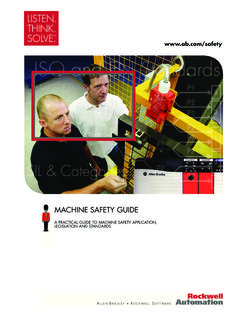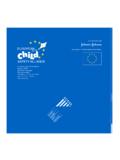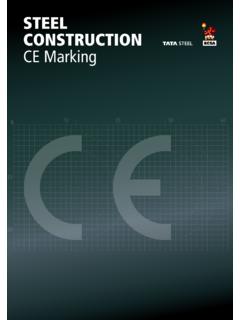Transcription of A5 Safety Cat CH3 - BARA
1 Chapter 3 european harmonised to the european harmonised 292-1 American of standards59 european HarmonisedStandards60 european HarmonisedStandards61 european Background to the european harmonised standards The standards prepared by the european standardisation bodies CENand CENELEC are common to all european community and EFTA countries. These standards were introduced in order to helpmachinery manufacturers conform to the requirements of theregulations. Generally speaking, the authorities will assume that anymachine manufactured to conform to the published Europeanstandards will comply with the Essential Health and SafetyRequirements covered by those IdentificationStandards may have a number of different prefixes:jwgprENENBS ENjwgThe joint working group prefix is normally followed by a joint working group meets to evolve a new or updated standardand consists of a team of experts with an interest in the subject,for example, development engineers for product-relatedinformation, representatives of the standards institutions, healthand Safety executives.
2 PrENThis stands for provisional euronorm and is a draft Europeanstandard. This is a standard issued for comment beforeratification. ENThe euronorm is the official european ENThe BS prefix in front of the euronorm number denotes that theBritish standards Institution has reviewed the EN standard andhas made any grammatical changes necessary to avoidconfusion. Please note that this guide does not show the BS prefix, referringsolely to the euronorm ClassificationThe standards have to be classified into three sections: A, B and A standardsThe A standards apply to all machinery and provide essentialinformation for all machine builders. There are three A standards thatrelate to machine Safety :EN 414EN 292 Parts 1 and 2EN EN 414 Entitled Safety of machinery. Rules for the drafting and presentationof Safety standards . This is effectively the standard for standards ,and evolved so that there could be conformity in the way standardsare EN 292 Parts 1 and 2 Entitled Safety of machinery.
3 Basic concepts, general principles fordesign . This standard defines the concepts of machine Safety andspecifies the general principles and techniques to help machinedesigners achieve EN 1050 Entitled Safety of machinery. Principles for risk assessment . Thisstandard describes how to assess the risk of injury or damage tohealth, so that appropriate Safety measures can be standardsB standards are subdivided into two sections:Group B1 covers Safety aspects for design, electrical equipment, Safety distances, Safety -related controls. These standards always B2 covers Safety components and devices, light curtains, mechanical guards, pressure mats and two-hand controls. These standards are applied when standardsThese standards identify specific types or groups of machinery andinform manufacturers and users about the specific Safety precautionsthey should take and Safety devices they should An American viewOther world-wide standards bodies such as IEC, ISO and,significantly, the American national standards body ANSI, are nowreaching agreement with CEN and CENELEC in order to reachcommon, world-wide standards .
4 The european requirement isalready very similar to that required by the American NationalStandards Institute (ANSI), as the following extracts from the ControlReliability Regulations show:OSHA (b)(13) Control ReliabilityThe control system shall be constructed so that a failure within thesystem does not prevent the normal stopping action from beingapplied to the equipment when required, but does prevent initiationof a successive stroke until the failure is corrected. The failure shallbe detectable by a simple test, or indicated by the control requirement does not apply to those elements of the controlsystem which have no effect on the protection against point ofoperation Section DefinitionsControl reliability is defined as a method of ensuring the integrityof the performance of guards, devices or control Section Control ReliabilityWhen required by the performance requirements of thesafeguarding, the device system or interface shall be designed,constructed and installed so that a single component within thedevice, interface or system shall not prevent the normal stoppingaction from taking place, but shall prevent a successive machinecycle.
5 This requirement does not apply to those components666 european HarmonisedStandardswhose function does not affect the safe operation of the machinetool. Further reference is made in ANSI Section (1996).ANSI Section Control Component Failure ProtectionThe control system shall be designed, constructed and installedso that a single control component failure within the system doesnot prevent the stopping action from taking place, but will preventsuccessive system cycles until the failure has been requirement only applies to those components whose failurecan result in a hazardous List of standardsThe following table lists some of the main standards supporting theMachinery 201 Rubber and plastics machines. Injection moulding machines. Safety 292-1 Safety of machinery. Basic concepts, general principles for design. Basic terminology, 292-2 Safety of machinery. Basic concepts, general principles for design. Technical principles and 294 Safety of machinery.
6 Safety distances to prevent danger zones being reached by the upper 349 Safety of machinery. Minimum gaps to avoid crushing of parts of the human 414 Safety of machinery. Rules for the drafting and presentation of Safety 418 Safety of machinery. Emergency stop equipment, functional aspects. Principles for 422 Rubber and plastics. Machines. Safety . Blow moulding machines intended for the production of hollow articles. Requirements for the design and construction. EN 457 Safety of machinery. Auditory danger signals. General requirements, design and HarmonisedStandardsStandardDescriptionEN 547-1 Safety of machinery. Human body measurements, etc. Part 1: principles for determining the dimensionsrequired for openings for whole body access into 547-2 Safety of machinery. Human body measurements, etc. Part 2: principles for determining the dimensionsrequired for access 563 Safety of machinery. Temperatures of touchable surfaces. Ergonomics data to establish temperature limit values for hot 574 Safety of machinery.
7 Two-hand 614 Safety of machinery. Ergonomic design 614-1 Safety of machinery. Ergonomic design 1: terminology and general 626 Safety of machinery. Reduction of risks to health from hazardous substances emitted by 626-1 Safety of machinery. Reduction of risks to health from hazardous substances emitted by machinery. Principles and specifications for machinery 626-2 Safety of machinery. Reduction of risk to health from hazardous substances emitted by machinery. Methodology leading to verification 689 Workplace atmospheres. Guidance for the assessment of exposure by inhalation to chemical agents for comparison with limit values and measurement 692 Mechanical presses. HarmonisedStandardsStandardDescriptionpr EN 693 Hydraulic presses. 811 Safety of machinery. Safety distances to prevent danger zones being reached by the lower limbs. EN 842 Safety of machinery. Visual danger signals. General requirements, design and 894-1 Safety of machinery.
8 Ergonomic requirements for the design of displays and control actuators. General principles for human interactions with control and display 894-2 Safety of machinery. Ergonomic requirements for the design of displays and control actuators. Displays. EN 894-3 Safety of machinery. Ergonomic requirements for the design of displays and control 953 Safety of machinery. Guards. General requirements for the design and construction of fixedand movable 954-1 Safety of machinery. Safety related parts of control systems. Part 1: general principles for 954-2 Safety of machinery. Safety related parts of control systems. 981 Safety of machinery. System of auditory and visual danger and information 982 Safety of machinery. Safety requirements for fluid power systems and their components. 983 Safety of machinery. Safety requirements for fluid power systems and their components. HarmonisedStandardsStandardDescriptionpr EN 999 Safety of machinery. Hand/arm speed.
9 Approach speed of parts of the body for the positioning of Safety 1005-1 Safety of machinery. Human physical one: terms and 1005-2 Safety of machinery. Human physical two: manual handling of objects associated to 1005-3 Safety of machinery. Human physical three: recommended force limits for machinery 1030-1 Hand-arm vibration. Guidelines for vibration hazard reduction. Part 1: engineering methods by design of 1032 Mechanical vibration. Testing of mobile machinery in order to determine the whole-body vibration emission value. General 1037 Safety of machinery. Prevention of 1050 Safety of machinery. Principles for risk 1088 Safety of machinery. Interlocking devices associat-ed with guards. Principles for design and 1093-1 Safety of machinery. Evaluation of the emission of airborne hazardous substances. Part one: selectionof test HarmonisedStandardsStandardDescriptionEN 1093-3 Safety of machinery. Evaluation of the emission of airborne hazardous substances.
10 Part three: emission rate of a real specified pollutant. Bench test method using the real 1093-4 Safety of machinery. Evaluation of the emission of airborne hazardous substances. Part four: capture efficiency of an exhaust system. Tracer 1127-1 Explosive atmospheres. Explosion prevention and protection. Basic concepts and 1299 Mechanical vibration and shock. Vibration isolation of machines. Information for the application of source 12622 Hydraulic press brakes. 31690-1 Acoustics. Noise control. Guidelines for the design of low-noise workplaces. Part 1: noise control 50099-1 Safety of machinery. Indicating, marking and actuating principles. Part 1: visual, audible and tactile 50099-2 Safety of machinery. Indicating, marking and actuating principles. Part 2: marking 50100-1 Safety of machinery. Electrosensitive protective devices. Part 1: general requirements and 50178 Electronic equipment for use in power 50179 Power installations exceeding 1 kV 60073 Basic and Safety principles for man-machine interface, marking and identification.








